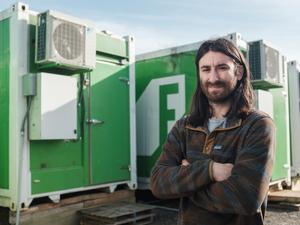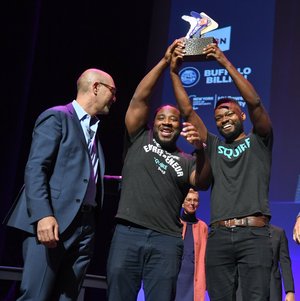
Rally’s decision to go public via a special purpose acquisition corp. was a surprise event in Buffalo. The past 43North winner announced a $208 million SPAC deal June 1.
The deal would see Rally combining with Americas Technology Acquisition Corp. and going public on the New York Stock Exchange by year-end.
The initial announcement was sparse in details, but subsequent investor documents posted to the Rally and ATA websites give a more holistic picture of the plan behind the deal.
“As we enter into this business combination, we’re poised to truly change an industry and create the first global brand in buses,” CEO Numaan Akram said in the June 7 presentation.
Akram and co-founder Siheun Song moved to Buffalo in early 2020 after becoming a winner in the 43North competition – taking home a $500,000 investment from 43North in exchange for 5% of the company.
They moved back to New York City earlier this year after struggling to build their business in a new city during the pandemic.
But Rally’s story in Buffalo is not over. 43North still owns a significant stake in the company. ACV Auctions co-founder and investor Jack Greco also showed up in the Rally financial documents as an angel investor.
Here’s what to know about the Rally deal going forward.
How much does 43North stand to make?
Rally will be the second major exit from the 43North portfolio after ACV Auctions went public via an initial public offering last year. The purpose is to take the proceeds from successful investments and reinvest in Buffalo’s startup economy.
It remains unclear precisely how much equity 43North has in Rally, but it’s likely less than the original 5% (it’s common for startups to dilute the ownership percentages of early investors as they raise new capital).
Even so, 43North’s on-paper ownership percentage of Rally is likely to be substantial as long as the stock performs well on the public markets. As a hypothetical exercise, 3% of $208 million is $6.24 million.
A spokeswoman for 43North declined to comment out of respect for Rally’s investor quiet period.
43North’s vice president of portfolio and selection, Kevin Siskar, posted a brief congratulatory video recently.
Akram also declined to comment for this story, referring a reporter to the presentation and supporting documents.
Another document giving more detail on individual investors will likely be filed in the coming months.
How do SPACS work?
SPACs are a way of taking companies public as an alternative to the initial public offering. As a SPAC, ATA was an investor-backed public company looking to combine with a high-growth business.
Rally has built a business out of the concept of “bus sharing,” where customers create on-demand trips that are supported by a marketplace of bus companies.
Existing shareholders in Rally will be granted public-market shares (under the RLLY ticker) to be valued at $165 million.
Those shareholders will be subject to a typical lockup for private investors, meaning they won’t be able to buy or sell shares for six months following the company’s listing.
Six months is a lifetime on the public markets. ACV debuted at $25, reached the upper $30s but then came back down to the $17 range before its lockup was over. DigitalOcean, led by Buffalo native Yancey Spruill, debuted on the NASDAQ at the same time as ACV. It sold shares during its IPO at $47. They immediately dipped to the $41 range. By the time six months had passed, DigitalOcean’s share price had eclipsed $80.
Will Rally become profitable?
Rally’s investor presentation conveyed all the markers of a high-growth startup. Company revenue hit $16.7 million in 2019 but dipped to $4.6 million as the pandemic slammed the transportation industry. The company’s business recovered to the tune of $10.7 million in 2021. Revenue is expected to triple this year and reach more than $100 million by 2024.
The company has run deficits of $4.3 million, $2.7 million and $2.3 million, respectively, over the last three years.
Rally expects to continue spending on growth but is on track to become profitable in three years, according to the presentation. In the meantime, it will use cash generated from its SPAC deal to launch with new customers, expand into new regions and ultimately put its brand “on hundreds of buses owned by local operators,” Akram told investors.
Rally leaders believe the company has a massive potential market – the presentation noted the company’s total addressable market is $135 billion.
“Rally is addressing an incredibly large market, both in the US, and internationally,” ATA CEO Jorge Marcos said. “Their product should benefit from broad-based support by business and governments, who are desperate for a solution like Rally’s to address transportation issues from an affordability, convenience, and environmental standpoint.”
Greco’s take
Greco got to know Rally when he was executive director of the short-lived Techstars Buffalo program, and he ended up investing in them on a convertible debt note (meaning it would turn into company equity during a future funding event). The investor documents indicate Greco’s note was turned into equity in April 2021, shortly after Rally’s merger with OurBus.
Greco said the SPAC is a “unique opportunity” for a company with major promise.
“I’m always looking for big markets that get overlooked, and I think it’s a great that Numaan will continue building this company,” he said.






